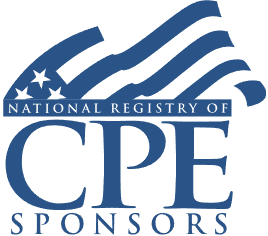Meeting Section 174 Capitalization Requirements for R&D
Identifying Assets, Applying Rev Proc 2023-11 for Automatic Changes, Current IRS Audit Trends

Course Details
- smart_display Format
On-Demand
- signal_cellular_alt Difficulty Level
Intermediate
- work Practice Area
Tax Preparer
- event Date
Thursday, March 21, 2024
- schedule Time
1:00 p.m. ET./10:00 a.m. PT
- timer Program Length
110 minutes
-
BARBRI is a NASBA CPE sponsor and this 110-minute webinar is accredited for 2.0 CPE credits.
-
BARBRI is an IRS-approved continuing education provider offering certified courses for Enrolled Agents (EA) and Tax Return Preparers (RTRP).
This webinar will discuss identifying Section 174 assets, the revised capitalization requirements, making the method change requirement in the second year, and the current state of IRS R&D audits. Our notable panel will provide advice on transitioning to the revised guidelines for businesses and tax advisers.
Faculty

As a tax partner for TaxOps Minimization, Ms. Overberg specializes in executing and managing a wide range of tax minimization strategies, including all aspects of the Research and Development tax credit as well as financial reporting requirements under FAS 109 and Fin 48. In addition, she works with Section 199, Section 263A, and Section 382 analysis, calculations, and reporting. She works primarily with clients in the automotive, engineering, manufacturing, software, biotech and oil and gas sectors, and has worked on numerous R&D tax controversy engagements
Description
Included in the Tax Act of 2017 was a requirement to amortize Section 174 expenses, generally over five years, beginning in 2022. The initial problem is defining and identifying these assets, which are defined under Section 1.174-2 as "… expenditures incurred in connection with the taxpayer's trade or business which represent research and development costs in the experimental or laboratory sense… . Whether expenditures qualify as research or experimental expenditures depends on the nature of the activity to which the expenditures relate, not the nature of the product or improvement being developed... ." The definition of qualifying assets is broad; the nature of the activity in which the asset is used dictates whether or not it is a Section 174 expense.
Making the transition has been a burden for many. Many businesses have and will continue to recognize significant income due to the change, while practitioners must grasp how to effectively make the transition. The IRS has released Revenue Procedure 2023-11, updated with 2023-24 and more recently 2024-9 to thoroughly confuse everyone. Further complicating matters, IRS has notices 2024-12 and 2023-63. Practitioners working with companies engaging in research and experimental activities need to understand the new R&D requirements.
Listen as our panel of R&D experts explains the latest guidelines and how to transition to the new reporting requirements.
Outline
- Background: R&D policy changes
- Review of implementation for 2022 tax year
- Evaluating recognition changes for 2023 tax year
- Revenue Procedure 2024-9 for automatic method change
- 174 computation
Benefits
The panel will review these and other key issues:
- Steps to facilitate the transition to capitalizing R&D expenditures
- Implementing an accounting method change after the initial year under all Revenue Procedures and Notices
- Identifying business activities and assets subject to the revised capitalization requirements
NASBA Details
Learning Objectives
After completing this course, you will be able to:
- Identify what is subject to Section 174 inclusion
- Determine steps to take to effectively transition to the new reporting requirements for R&D
- Ascertain actions to take to prepare for an IRS and state R&D audits
- Decide which specific activities qualify an expenditure as a Section 174 asset
- Field of Study: Taxes
- Level of Knowledge: Intermediate
- Advance Preparation: None
- Teaching Method: Seminar/Lecture
- Delivery Method: Group-Internet (via computer)
- Attendance Monitoring Method: Attendance is monitored electronically via a participant's PIN and through a series of attendance verification prompts displayed throughout the program
- Prerequisite: Three years+ business or public firm experience preparing complex tax forms and schedules, supervising other preparers or accountants. Specific knowledge and understanding of pass-through taxation, including taxation of partnerships, S corporations and their respective partners and shareholders.

Strafford Publications, Inc. is registered with the National Association of State Boards of Accountancy (NASBA) as a sponsor of continuing professional education on the National Registry of CPE Sponsors. State boards of Accountancy have final authority on the acceptance of individual courses for CPE Credits. Complaints regarding registered sponsons may be submitted to NASBA through its website: www.nasbaregistry.org.

Strafford is an IRS-approved continuing education provider offering certified courses for Enrolled Agents (EA) and Tax Return Preparers (RTRP).
Unlimited access to premium CLE courses:
- Annual access
- Available live and on-demand
- Best for attorneys and legal professionals
Unlimited access to premium CPE courses.:
- Annual access
- Available live and on-demand
- Best for CPAs and tax professionals
Unlimited access to premium CLE, CPE, Professional Skills and Practice-Ready courses.:
- Annual access
- Available live and on-demand
- Best for legal, accounting, and tax professionals
Unlimited access to Professional Skills and Practice-Ready courses:
- Annual access
- Available on-demand
- Best for new attorneys
Related Courses

Admitting New Partners: Tax Consequences
Friday, May 30, 2025
1:00 p.m. ET./10:00 a.m. PT

Key Issues in Succession Planning: Buy-Sell Agreements, Equity Grants, Profits Interests, Tax Considerations
Tuesday, June 17, 2025
1:00 p.m. ET./10:00 a.m. PT
Recommended Resources
How CPE Can Bridge the Gap Between What You Know and What You Need to Know
- Career Advancement